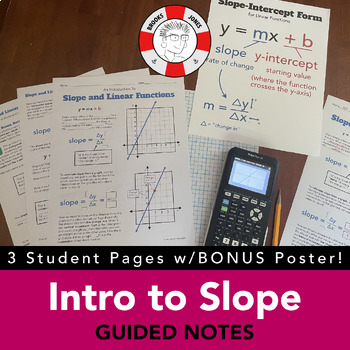Intro to Slope and Linear Functions: Guided Notes and BONUS! Poster
- PDF
Description
Give your students the best foundation for a solid understanding of slope and linear functions with this fill-in guided notes activity. Students will calculate slope from a graph of a linear function as well as from a table of values, and deconstruct y = mx + b and examine the difference between the y-intercept (b) and slope (m). In addition, students will explore the difference between the dependent variable (y) and independent variable (x) and find out how to analyze a word problem and use a linear function to model a two-variable situation.
Features shown and vocabulary terms defined include slope, rate of change, coefficient, slope-intercept form, y-intercept, solving a two-step, single variable equation, as well as the m- and b-values from the equation. Full key included as well as a bonus classroom poster to keep concepts front of mind for students. This activity aligns with Common Core State Standards 8.F.A.2, 8.F.A.3, and 8.F.B.4, but can be used to review or remediate in higher-level classes such as Algebra I. Full key included. Error-free money-back guarantee!
If you like this resource, please consider following me to get notified of new products and upcoming sales! —-> Click here





